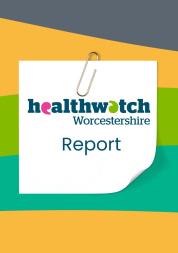Young Peoples' Health and Emotional Wellbeing Report

We heard from a total of 249 young people from all six districts of Worcestershire:
- 154 young people completed our survey online, ages ranged from 13-25.
- 38% (58 out of 154) of all young people taking part in our survey said that they had a disability or long-term health condition.
- 11 young people identified as gender diverse.
- 53 young people identified as neurodiverse.
- 95 were young members of Speakeasy NOW (a Worcestershire based Learning Disability support charity) and took part by participating in workshops using discussion themes based on our survey.
Young people’s physical health is mainly good, but they experience poorer emotional wellbeing / mental health.
Over half of girls aged between 13-25 described their emotional wellbeing / mental health as ‘not so good’ or ‘poor’
When asked if the felt they had enough information about looking after their emotional wellbeing / mental health, 49% of girls and 50% of gender diverse young people answered ‘No’ or ‘Not sure’.
Around a fifth of the young people told us that they had NOT been able to find information, particularly around: Emotional wellbeing / mental health; neurodiversity; transition to adult services.
Young people have told us that although they may be aware of local (Worcestershire based) online information on health and wellbeing, their willingness to use it is low.
A significant amount – nearly half – of young people have stopped doing activities that are fun and relaxing in the last year due to poor mental health and/or rising costs and their family’s financial situation.
10 young people told us that they did not have anyone they could talk to if something was worrying them, or they felt unhappy. Only 31% of the young people felt they definitely had someone they could talk to.
Young people are telling us very clearly that the type of support that they would find helpful are one-to-one in-person sessions. They are reluctant to use video calling or group sessions and are likely to reject or refuse to engage with these options.
Gender identity
11 young people told us they identified as gender diverse. 4 out of these 11 young people felt they needed support around their gender identity but, despite asking, had not received any.
Those that had received support found it mixed. They were relying on school/college staff and their family and friends around them – who were usually doing their best – whilst receiving no professional support during long waiting times for appointments.
In this survey, ALL 11 (100%) of the young people who identified or thought they might identify as gender diverse also identified as neurodiverse.
Neurodiversity
Out of all the young people taking part in our survey, 34% (53 out of 154) said that they identified or thought they might identify as neurodiverse.
Just under half of these young people did not have an education and health care plan (EHCP) in place to set out their support and treatment requirements.
Of those who did have an EHCP, over half said it did not provide the support they needed.
Neurodiverse young people have told us that both their physical and emotional wellbeing / mental health are proportionally worse than their neurotypical peers. Their access to information about health and wellbeing was poorer too.
Neurodiverse young people have told us they are affected by the same issues – such as rising cost of living, poor mental health – as all young people. However, the degree to which these issues are impacting neurodiverse young people appears to be greater.
Learning Disability
Most young people with Learning Disabilities would go to professionals (e.g. their support worker, or a medical professional) for information about health and emotional wellbeing – few would use online options.
Exercising or taking part in sport was one of the least popular activities.
Young people with learning disabilities told us they are stopping exercising or swimming due to rising costs.
The most popular support option for emotional wellbeing for the young people with learning disabilities is group sessions – the least popular are online / web / or video conferencing options.
Our Recommendations
We have made 26 recommendations for Worcestershire’s health and social care services based on our findings.
Our recommendations cover the following areas:
- Access to information on Health and Emotional Wellbeing
- Access to affordable healthy activities
- Access to in-person emotional support
- Transition to adult services
- Gender identity
- Neurodiversity
- Education, Health and Care Plans (EHCP)
- Young people with learning disabilities
We have requested an integrated care system response to these recommendations, which will be published here when it has been received.
For copies of the Appendices to this Report please contact us
